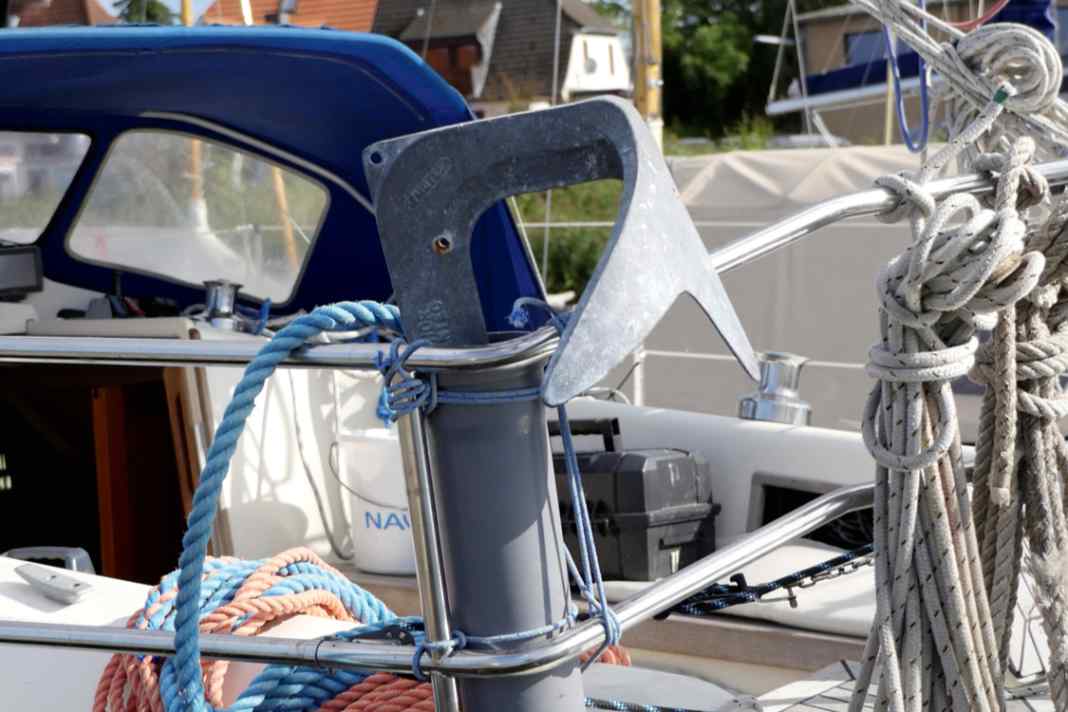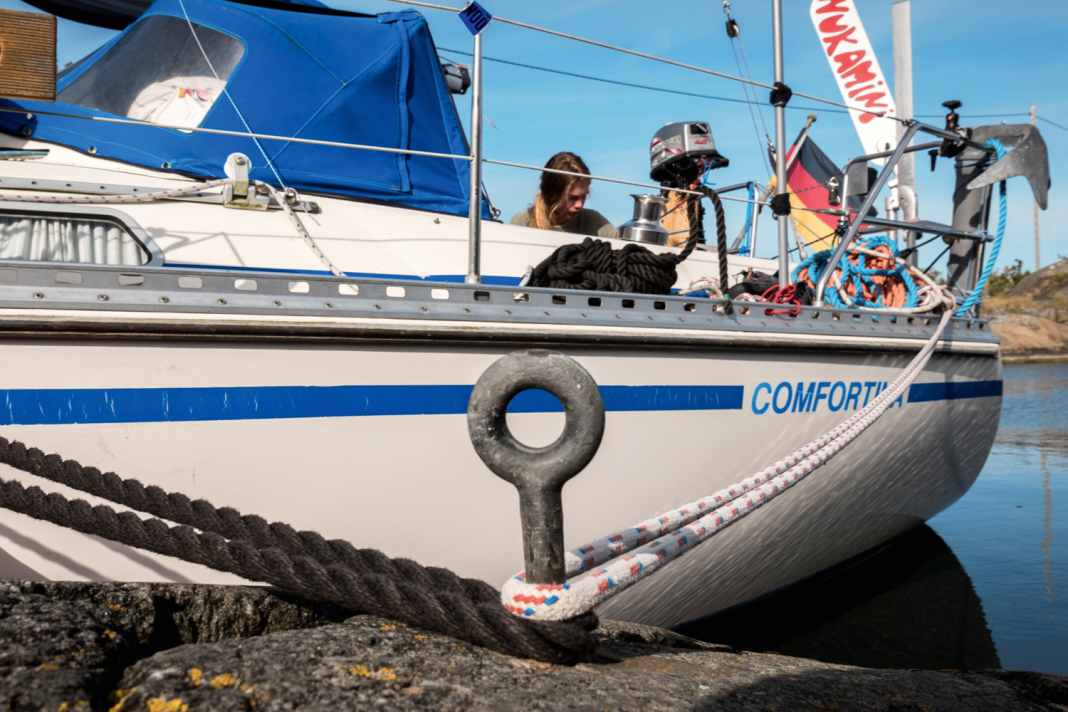





Sailing summer in Sweden, it's the beginning of August and midsummer at its best. The search for a berth begins in the late afternoon, the harbours are overcrowded. Even in the third, really packed harbour, there is nothing to be found in the search for a cosy berth for the night.
Swedes, Danes, Germans, Norwegians and Finns are all on holiday at the moment, making for a chaotic scene. If you're lucky, you'll get a place in the second row instead of the idyllic sundowner you'd hoped for in a quiet corner of a tranquil harbour. Or is it?
Also interesting:
Or we simply continue on and do something that is absolutely common here: mooring on the rocks. With the great opportunity to simply step ashore from the boat, without a dinghy, without a jetty, without a harbour, simply in the middle of nature. Mooring on the skerry, the rock in front of the stern anchor or even alongside is the Scandinavian answer to overcrowded harbours. Once you have internalised this mooring technique, sailing trips to the north take on a whole new quality. There are new rocks around every corner that need to be explored for their suitability for mooring. Despite the high season, it is often possible to moor in complete solitude, sometimes even on your very own mini-island.
When we moored for the first time in Sweden many years ago, it was a revival experience for me. Suddenly we were able to move around Sweden without stress. In the middle of the holiday season, there was suddenly no longer any reason to call at a harbour at midday on the hunt for the last free berth. Apart from that, the feeling of being able to moor and spend the night in the comfort of your own boat in the middle of the most amazing solitude in a harbour created by nature is brilliant.
Of course, there is no comfort on land. There is no electricity, no running water, no showers, no barbecue areas with tables and benches, no rubbish bins, no shop - in fact, there is nothing at all except the skerry, which is still warm from the heat of the day. And when our ship is safely moored and rocking along, bathed in the orange evening light, all the comforts of a harbour are quickly forgotten.
The equipment
Before setting off into the rocks, pay attention to your equipment. It may be necessary to stock up in order to be well equipped for all eventualities.
Rear anchor
Most Swedes use an M-anchor at the stern. This is usually one size smaller than the bow anchor. Ideally, its only task is to keep the stern of the boat pointing in the right direction when it is lying in the cover of the skerry to which it is moored. In this case, little or no load is placed on the stern anchor as long as the wind is not shifting.
Local sailors in the archipelago areas all use so-called webbing pulleys on the pushpit. Anchor, chain lead and the aforementioned roller ensure stress-free unwinding and rewinding of the anchor line. If, like most of us, you are only in the rocky area from time to time, a line with a chain lead or an anchor line with a lead insert is also sufficient. A length of at least 30 metres is recommended.
While many Scandinavian boats have special stainless steel stern anchor fittings, a plastic pipe from the sanitary area is also sufficient for a one-off holiday. Stapled to the pushpit with cable ties, it makes a good anchor holder. The temporary arrangement can be removed again after your holiday.
The basics of equipment for archipelago sailors




Long leader lines
Two are usually enough, four are better, but more won't do any harm. They should be 20 to 30 metres long as they are used for slips in case you have to cast off quickly due to shifting winds. In very narrow bays, it sometimes makes sense not to lie in front of the stern anchor, but to lay a shore line aft on the nearest rock. However, this should not be a floating line. This is because there is then the possibility of fiddling the line to the bottom to allow other boats to pass.
Sash nails
There are straight and offset ones. The straight ones are for relatively flat rocks where the crevice is roughly perpendicular to the angle of incidence of the leader. The angled ones are useful if they are to be attached in a vertical crevice. Due to the lever arm, they wedge themselves in there, whereas the straight ones would be pulled out again under load in such a place. Two of each should be part of the basic equipment.
Hammer
Hammers weighing between 1 and 2 kilograms have proven to be effective for getting the warping nails in and out of a crevice. In Sweden, rot-proof versions with metal handles are available especially for this purpose.
Fender
If you also want to moor alongside the rock, and this is highly recommended, fenders in different sizes are essential. Large ball fenders can also be used very profitably.
Bow ladder
If you don't like jumping off the boat, you can make it much easier to get off with a hook-in bow ladder. They are available for universal use from well-stocked equipment dealers
The berth search
The first step in the successful search for a sheltered spot between the stones is to get the most accurate weather forecast possible. Generally, light winds or even calm days are recommended for the beginning. The forecast is also extremely important. Nobody wants to wake up hanging from the stern anchor with only 30 centimetres of space between the bow and the rocks. Therefore, before mooring, it is important to find out where the wind will blow from until the next morning, ideally without shifting and as lightly as possible.
Waves and swell can also spoil the peace and quiet of rocky moorings. It is therefore important to consider whether regular shipping traffic from ferries or freighters causes swell at the berth. If there is very little space between the rock and the bow and often also under the keel, this is an exclusion criterion. In order to find the best place for the respective situation, all possible information is utilised. Tips from locals are the best. Nothing is better than years of experience.
In addition to area guides, where rock moorings are also explicitly covered, there are digital nautical charts in which archipelago moorings are listed. There is also information via Google Earth, travel reports and internet forums. Once an interesting bay that is sheltered from the prevailing wind direction has been identified, the possibility of being able to anchor there freely is investigated. This makes the search much easier. Latecomers are not forced to move on in the dark if all the places on the rocks are already occupied.
Firm connection with the stones




Once you have arrived at your destination, it's time to choose a mooring and explore the surroundings. Are there already rocky moorings with boats of a similar size or only motorboats with a shallow draught? The shore is scanned for suitable spots with binoculars. If there are places marked on the nautical chart, check their suitability. As a rule of thumb, the rocks below the water surface should be as steep or flat as those above.
A steep course is good in that it is probably deep until just before the rock, but on the other hand, getting off the boat and onto land is a big challenge if the rock is very steep and not entirely without danger, especially if the stones are wet. Whether the skerry at the chosen location is suitable for the crew to go ashore and fulfil their wishes, such as barbecuing, swimming or taking the dog for a walk across the skerry, must be decided on an individual basis. Of course, it makes a difference whether you want to sail on the next morning or stay on the skerry for a few days of swimming.
It is usually possible to see how the boat will be moored before it is moored. There are often eyebolts at the favourite mooring spots. Otherwise, you need to keep an eye out for exposed boulders, trees or crevices into which you can hammer your own nails.
Three manoeuvres for mooring at the skerry
Mooring with stern anchor
The echo sounder is recalibrated once at the start of every holiday in Sweden. To do this, simply sound the depth over rocky ground in the range of 2 to 4 metres using a line and weight and compare it with the display. When passing through shallows or approaching rocks, an exact match of the values is very reassuring. Once the decision has been made in favour of an apparently ideal spot, start the first approach at a slow speed to test it without throwing the stern anchor.
A crew member at the bow signals the remaining distance to the skerry to the helmsman using agreed hand signals. During the last few metres, he tries to estimate the depth directly in front of the rock. If there is any doubt as to whether it is correct or if visibility is too poor, she will signal to abort. The helmsman heads for the predetermined landmark as slowly as possible. It should be borne in mind that there may well be a slight grounding. For this reason, the last few metres are covered at an absolute crawl. Once the rock has been reached so that it is safe to climb over it, the test run is cancelled as planned and the boat is driven back.
Now the actual feeder is discussed and everything necessary is prepared. How many lines will be used, do they have to be extremely long? Are there any fastening options on the skerry, or will you need your own rock nails and a hammer - then you can take them ashore in a bailer provided. If a pulpit ladder is on board, this should now be hooked in. You should also make sure that the rock is really bone dry, at least in the exit area. Damp or even wet skerries can be as slippery as soft soap. This makes such a manoeuvre a suicide mission in the truest sense of the word.
The crew member who is the most athletic has the job of climbing over. Sturdy shoes must be worn for this, even if it is warm and flip-flops would be more comfortable on the feet. But wearing them, or even walking barefoot, is not cool in such a mission, but dangerous.
Once everything is ready and the roles are distributed, the final mooring manoeuvre follows. Two to three boat lengths before reaching the skerry, the stern anchor is dropped and the anchor line, which has hopefully been properly rigged beforehand, can be released as expected. The person at the helm runs the anchor line loosely over a winch in the cockpit. Hand signals for direction and distance are given from the bow. Approximately one metre before reaching the rock, the two head lines are thrown ashore and you position yourself on the bow ladder or the anchor fitting as far forward as possible on the ship.
If it is really safe to climb over, the person at the bow signals this and the helmsman stops with a fist: "Stop" and climbs over. If there is a little crosswind, they first attach the air line to an archipelago hook, rock or tree. Then the leeward line. Now the anchor line can be passed aft with the winch. It is easy to see whether the stern anchor is digging in properly.
When the anchor line is finally tied to a stern cleat, the helmsman moves forwards and helps to put the shore lines to slip. Moored in this way, it is possible to quickly cast off from the rock in the event of an unforeseen wind shift without having to go ashore first. If the boat is very close to the rock, it should be moved a little astern for the night. Of course, this is also only possible from the boat with the lines lying on the slip.
The Swedes do not even run their lines through the eye of the eyebolt, but simply around the entire bolt. This way you don't run the risk of kinks forming in front of the eye and preventing the line from being hauled in. In such a case, you would have to go back to the rock and climb over it again or even sacrifice the line. If you have a crosswind or expect one during the mooring time, you can lay an additional shore line from the corresponding centre cleat ashore to relieve the stern anchor.
Exploratory trip in advance
If a dinghy is being towed behind on the trip through the archipelago anyway, then a crew member can also set off with it and check the water depth at the potential mooring point, get ashore there and take the lines. Ideally, there should be at least three of you travelling in such a case.
If there are free berths right next to ours, it's good manners to hang out the fenders. For Swedish sailors, it is completely normal to go to a rock, even if you are lying hull to hull with your neighbour. You shouldn't turn up your nose at this, but rather socialise and take tips with you for the next few days. It goes without saying that you should take the lines from a neighbouring yacht and provide information about the water depth directly on the rock.
Tail first
And why is it customary to go to the skerry with the bow and not the stern first? You could then use the bow anchor and get out via the bathing platform. Such manoeuvres are occasionally observed. However, you should then be one hundred per cent sure that you have enough water under the rudder. Because if a slight grounding with the bow or keel can be tolerated at absolute crawl speed, this should never happen with the comparatively unstable rudder.
Longside loungers on the rock
Much rarer are the places where you can moor alongside the rock. Once you have found such a rock, you can anchor there without a stern anchor, as if you were on a jetty. It is best to ask locals about such spots or anchor freely in a place where others are moored alongside nearby. If they then leave their spot, you know that it will probably be suitable for your own, at least for boats with a similar draught. For many sailors who make their holiday trip to the archipelago waters, lying alongside a rock is the crowning glory of the whole trip.
The most important thing here is to fender the boat correctly. If you have an onshore wind and the rock does not run absolutely vertically into the water, the fenders tend to move slowly upwards between the sloping rock and the sloping hull wall until they crunch. Fenders of different sizes and textures are the best way of levelling out uneven rock faces. Here, too, the rule of thumb is to make your first attempts with little offshore wind.
Sometimes you find yourself alongside between two yachts that are anchored stern-to. When casting off, depending on the circumstances, a situation can arise in which you pass relatively close to the stern of the neighbouring yachts. The Swedes are aware of this and will then tie their stern anchor line briefly to the bottom so that we don't come into conflict with it. So make sure that there is someone on board the yacht in question to help.
Summary
Nobody visiting Sweden by boat should miss out on mooring on an archipelago. It's just too special and so different from what we mean by anchoring at home. The combination of not having to be in the harbour, but still being able to get ashore just like that, is simply brilliant. What's more, in a fantastic landscape that is so wonderfully unfamiliar to us.
If you follow the previous tips, it is doable for all crews, perhaps with a little excitement the first few times. For us, sailing through the inner archipelago is the thing to do on any holiday in Sweden.
Author Mike Peuker


